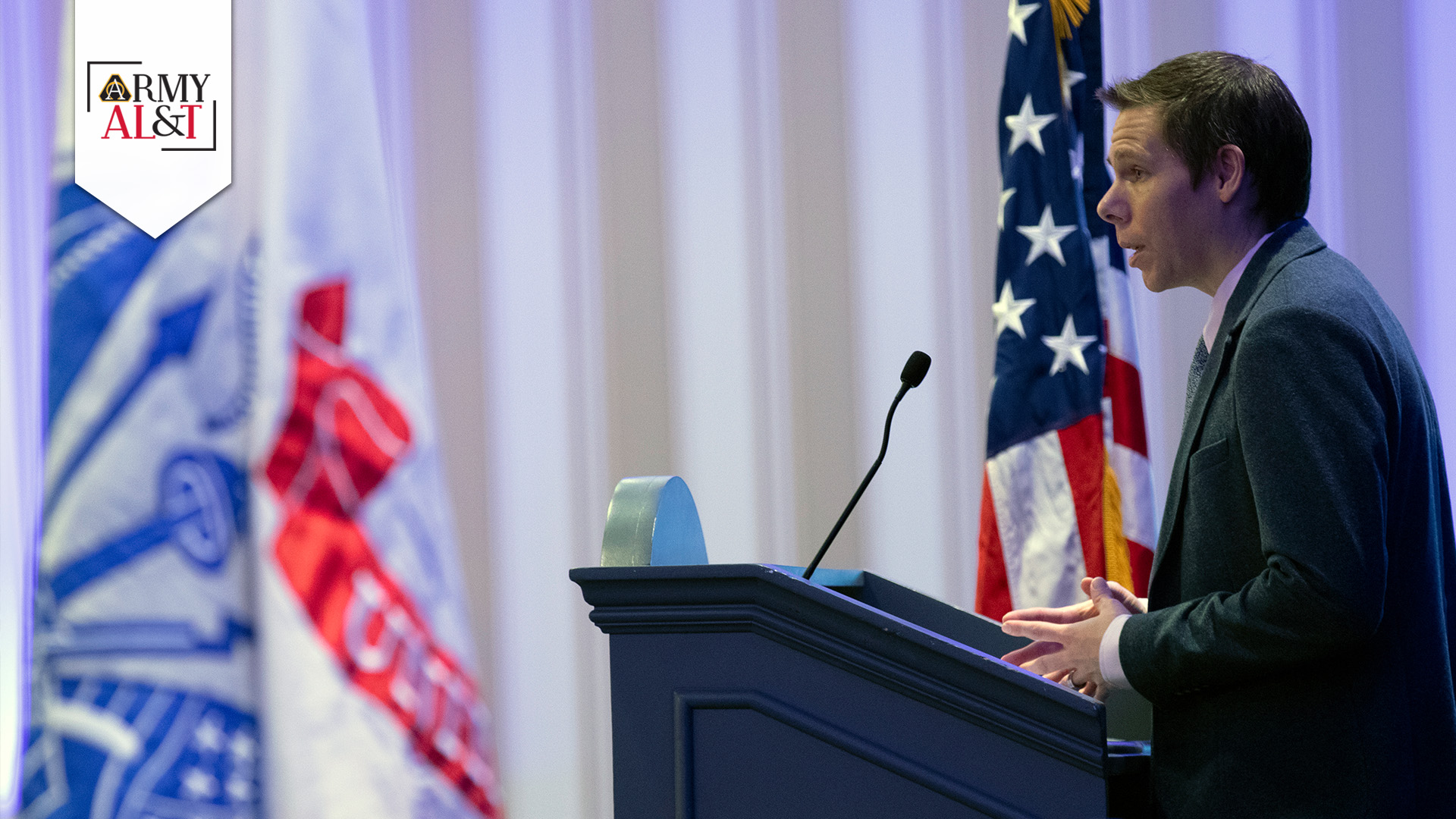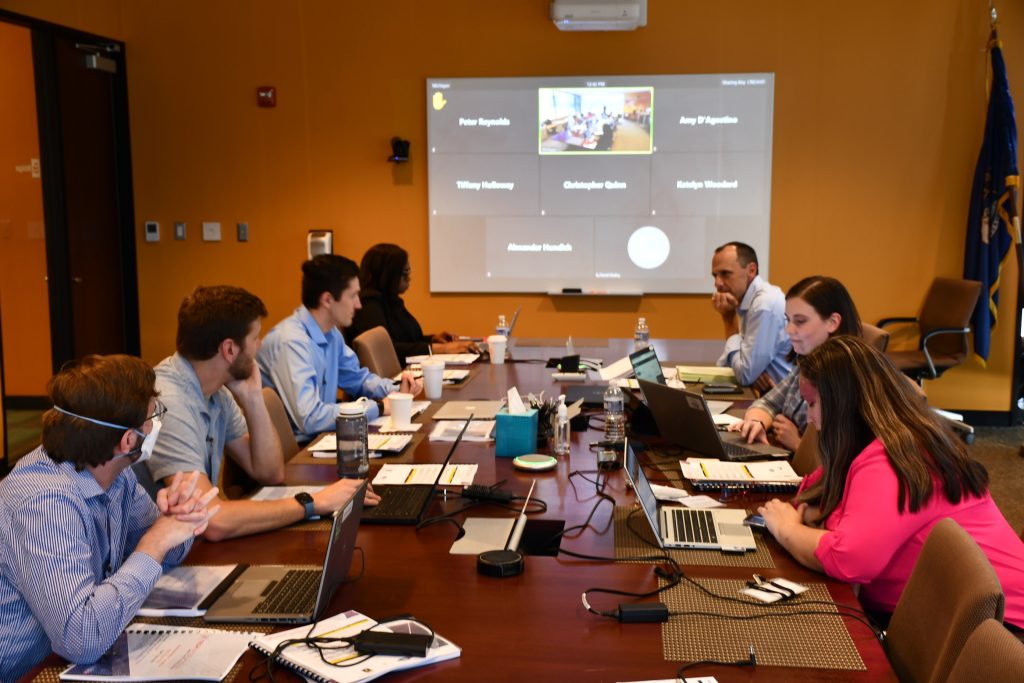
FUTURE IDEATORS: Matthew Willis, Ph.D., speaks at Black Engineer of the Year Awards (BEYA) Science, Technology, Engineering and Math Conference, Feb. 11, 2023, in Maryland. (Photo by Austin Thomas, Army Futures Command)
ASA(ALT)’s Army SBIR CATALYST Program incentivizes collaboration with industry to overcome transition barriers and build the Army of 2030.
by Daniel Smoot
The Office of the Assistant Secretary of the Army for Acquisition, Logistics and Technology (ASA(ALT)) provides the American Soldier a decisive advantage in any mission by developing, acquiring and sustaining the world’s finest equipment and services.
In that same vein, the congressionally funded and ASA(ALT)-sponsored Army Small Business Innovation Research (SBIR) and Small Business Technology Transfer (STTR) programs are competitive, contract award-based initiatives that allow Soldiers and Army experts to solve technological challenges.
FOSTERING INNOVATION
Through the Army SBIR and STTR programs, ASA(ALT) provides small and nontraditional businesses with contract opportunities for solutions that show technical merit, feasibility and commercial potential.
The Army SBIR CATALYST Program is a new ASA(ALT)-led mechanism designed to further accelerate and support disruptive innovation while cultivating collaboration with the defense industrial base—the industrial complex prioritizing the research, development and delivery of military capability.
The transition from conceptualization to fruition happened quickly for the novel effort. Announced by Under Secretary of the Army Gabe Camarillo at the October 2022 Association of the United States Army Annual Meeting and Exposition, the Army SBIR CATALYST Program is one of five new initiatives—alongside xTechPrime, the Army Tech Marketplace, Intellectual Property Cadre and Project VISTA—incentivizing collaborative efforts with industry.
The pilot launched shortly thereafter, in February 2023, demonstrating ASA(ALT)’s responsiveness at the point of need to unite small businesses and major weapons systems integrators to drive innovation.
LAUNCHING CATALYST
All five of ASA(ALT)’s latest initiatives capitalize on the speed and innovation of small businesses, and the stability and expertise of technology integrators through additional funding—and the Army SBIR CATALYST Program’s pilot was the first to launch.
ASA(ALT), and its Office of Army Prize Competitions and the Army Applied SBIR Program, lead the Army SBIR CATALYST Program to alleviate and overcome constraints in the defense industrial base.
|
XTECHPRIME TEAMS INTEGRATORS As the U.S. Army’s premier prize competition, the xTech Program enables small businesses to compete for cash prizes that are nondilutive—enabling financing where the business does not lose any equity—with some competitions also awarding SBIR contracts to accelerate and transition winners’ transformative technology solutions to the Army. As one of Under Secretary Camarillo’s new initiatives, the xTechPrime competition builds on the existing program by providing greater resources and opportunities to small businesses. Launched in April, it challenges nontraditional vendors to team with technology integrators to submit their innovative solutions that contribute to the Army’s current modernization goals while supporting a resilient industrial base. Small businesses can showcase their innovative technology solutions, with the potential to receive significant funding through the Army’s $28.5 million investment. Meanwhile, technology integrators provide expertise and resources to scale up technologies through continued collaboration with small businesses as they integrate their solutions into the Army ecosystem. “xTechPrime empowers small businesses and technology integrators to partner as teams and accelerate the transition of novel and often overlooked ideas by leveraging the resources of technology integrators,” said Matthew Willis, Ph.D., director of Army Prize Competitions and the Army Applied SBIR Program. “It is important that we support these relationships to address innovation challenges within the Army and across industry.” xTechPrime is an open-topic competition that accepts proposals for a variety of concepts. However, it prioritized solutions within artificial intelligence and machine learning; autonomy; climate and clean technologies; immersive and wearables; and sensors. As a result, a panel of Army subject matter experts selected 50 participants—who submitted white papers aligning with these focus areas—to move forward and partake in a networking forum at the August Fed Supernova defense innovation event in Austin, Texas. Alongside this opportunity and the Army’s total investment of $28.5 million, semifinalists received $5,000; continue to compete for $40,000 in nondilutive cash prizes; and, for the winners, have the potential for $1.9 million in Direct to Phase II SBIR contract awards. Throughout each round, judges will provide feedback to participants to help accelerate the transition of technologies to Army users. The panel of experts will offer insight on the best applications for the technologies, suggestions for product improvements for Army use and the next steps for development. “This competition plays a key role in the under secretary’s strategic initiatives,” Willis said. “It capitalizes on xTech’s proven competition model while supporting industry and the potential integration of scalable, Soldier-driven solutions.” xTechPrime is the first prize competition since the program’s launch in 2018 to focus on partnerships between small businesses and technology integrators, with incentives for each participating group. While the format of xTechPrime deviates from the standard xTech model with the addition of the small business and technology integrator teaming, a critical xTech component remains constant across all competitions—xTech’s dedication to providing not only financial gains but also feedback, mentorship and networking from Army experts. For information on the xTech Program and other upcoming competitions, go to www.xtech.army.mil. —DANIEL SMOOT |
Companies often develop concepts that lead to prototypes. However, there is a gap between prototyping and the transition of equipment into the hands of Soldiers. The Department of Defense refers to this as the “Valley of Death”—a long and arduous acquisition process where vendors face multiple barriers in transitioning their technologies to programs of record.
Despite the need for innovations that support the National Defense Strategy and offer commercialization potential, solutions frequently focus on unique Army challenges. Technologies that fall within these niches take time to mature as they navigate regulations and potential commercialization. These factors contribute to obstacles relating to the Valley of Death, and are a reason behind the implementation of the Army SBIR CATALYST Program.
To overcome these hurdles, and better support the defense industrial base, the Army SBIR CATALYST Program accelerates innovation using over $75 million in matching capital from Army customers, integrators and the Army Applied SBIR Program.
Comprised of small-, medium- and large-size businesses, the defense industrial base is essential for not only a strong military but also for a robust commercial sector. Data from a 2022 Congressional Research Service report shows that over 200,000 companies make up the defense industrial base. Meanwhile, the U.S. Chamber of Commerce notes that small businesses account for 99.9 percent of all businesses in the U.S. but only 25 percent of all DOD prime contracts.

JUDGING TECH: Judges consider six international companies’ pitches in the electric power and energy technology area at the conclusion of xTech International, July 13, 2022, at Detroit Arsenal, Michigan. The U.S. Army has partnered with the Air Force and Navy to discover small businesses from around the globe with innovative dual-use technology for the defense industry through this prize competition. (Photo by Jerome Aliotta, DEVCOM Ground Vehicle Systems Center)
SMALL BUT MIGHTY
Small businesses offer agility and creativity that often lead to innovative ideas and disruptive solutions. These benefits make them a sought-after market for emerging technologies for DOD, technology integrators and venture capital firms. Expanding collaboration with these small businesses presents a valuable opportunity to tap into their innovations, enhance the defense innovation ecosystem and achieve leap-ahead capabilities. The Army SBIR/STTR Program specifically invests in companies focused on developing dual-use technologies that benefit Soldiers on the modern battlefield.
This creates a win-win situation for technology integrators and small businesses, as integrators provide the resources and experience needed to scale manufacturing and to meet Army needs. With the Army SBIR CATALYST Program, the Army can better support these firms while bridging the capability and transition gap between innovators and national defense priorities.
During the 2023 pilot year, the Army SBIR CATALYST Program selected five small businesses to receive base contracts of $1 million each for a six- to 12-month performance period. Each of the selected small businesses identified Army customers and interested technology integrators for the capabilities in their proposed solutions.
To participate, each selectee must have previously received an Army SBIR/STTR contract within the past four fiscal years, while not having yet received a second SBIR/STTR Phase II under the same project. Following these criteria, the pilot accepted a wide array of proposals from businesses capable of supporting the Army’s future force. However, it prioritized solutions within specific technology ecosystems.
Areas of focus included climate and clean technology in the face of climate change; artificial intelligence and machine learning resiliency; supply-chain logistics; immersive and wearables; and contested autonomy. The Army selected ANDRO Computational LLC; Compound Eye Inc.; EM Photonics Inc.; R-Dex Systems Inc.; and Solvus Global LLC for their proposals within these fields and their ability to support key efforts, including the Army Climate Strategy and the Army Digital Transformation Strategy.
NEXT STEPS
Through their selections in the base phase and the Army’s $75 million investment, recipients can receive Army SBIR CATALYST Enhancement Phase II contracts of $7 million in Army SBIR funds, $3.5 million in funding from the Army transition partner and another $3.5 million from the partnered technology integrator. The result is total funding of $15 million for each small business based on a fund ratio of 2:1:1 over an additional 12- to 24-month performance period.
Upon conclusion of the program, these businesses’ solutions can potentially transition to critical Army partners, such as the Program Executive Office (PEO) for Intelligence, Electronic Warfare and Sensors’ Product Lead Tactical Space Superiorities and Project Director Sensors-Aerial Intelligence; PEO Ground Combat Systems and its Project Manager Main Battle Tank Systems; PEO Soldier’s Product Manager Individual Weapons; the U.S. Army Combat Capabilities Development Command (DEVCOM) Armaments Center, and DEVCOM Army Research Laboratory.
“This is the first SBIR program initiative designed to leverage untapped potential by heavily investing and building a shared risk structure between small businesses, Army transition partners and technology integrators,” said Matthew Willis, Ph.D., director of Army Prize Competitions and the Army Applied SBIR Program, within the Office of the ASA(ALT). “Through this pilot—and drastic increase in Army funding— we can drive down risk while providing greater resources to advance prototype development, testing and transition.”
ASA(ALT)’s pilot effort and selectees can help shape future iterations of the Army SBIR CATALYST Program, and the involvement of Army customers and integrators. Building on the feedback and experiences of small businesses, integrators and Army customers, the Army will further streamline the program to improve the success of small businesses and integrators, and its exposure to nontraditional vendors, via increased funding and an optimized potential pathway to crossing the Valley of Death.
CONCLUSION
These collaborations with Army customers and the defense industrial base can also catalyze and accelerate the rate of innovation while supporting existing mechanisms for technology transition. As the initiative grows, the Army SBIR CATALYST Program will complement ASA(ALT)’s existing SBIR/STTR contract efforts via additional opportunities and funding that support commercial industrial success—and through Army advancements capable of solving current and future challenges.
Willis will speak about the next iteration of the Army SBIR CATALYST Program at the October 2023 AUSA Annual Meeting and Exposition in Washington, as part of the Army Office of Small Business Programs seminars.
For more information, go to https://www.armysbir.army.mil.
DANIEL SMOOT provides contract support to the U.S. Army SBIR, STTR and xTech programs for Booz Allen Hamilton. He holds a B.S. in writing from Towson University.







